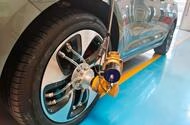Testing the Limits: How Remote-Controlled Tyre Deflation is Revolutionizing Autonomous Vehicle Safety
When it comes to autonomous and semi-autonomous vehicles, safety testing is evolving at a rapid pace. One of the most pressing questions for engineers and testers alike is: what happens if a tyre suddenly deflates while the vehicle is driving itself? Understanding how these vehicles respond to such emergencies is crucial for their development and deployment. Enter the innovative Te.Sense Bloom, a remote-controlled tyre deflation kit developed by Koala Technologies, designed to simulate real-world tyre failures in a controlled environment.
What Is the Te.Sense Bloom and How Does It Work?
The Te.Sense Bloom is a groundbreaking piece of equipment that allows testers to deflate a tyre remotely from inside the vehicle. This technology meets stringent safety regulations, including the FMVSS 110 US federal standard, which ensures that tyres can handle the load they’re subjected to and remain on the rim during deflation at speed. This is particularly important for autonomous vehicles, which must be able to react appropriately to sudden changes in tyre pressure.
The kit is mounted onto the wheel and features a central air ejector valve. When activated, this valve quickly releases air from the tyre, mimicking the effects of a blowout. The system is connected to the tyre through tubes and connectors, making it easy to install and use. With the push of a button, testers can create an instant loss of pressure, allowing them to observe how the vehicle behaves under these critical conditions.
Why Is This Technology Important for Testing?
Traditional methods of testing tyre deflation often involve destroying multiple tyres, which is not only costly but also raises sustainability concerns. For instance, testers might drive a vehicle over a series of aggressive ‘cleats’ that rapidly deflate and damage two tyres on one side. This approach has its drawbacks: it may not accurately simulate the conditions needed for certain stability tests, and it results in unnecessary waste.
The Te.Sense Bloom addresses these issues head-on. It can be installed on any corner of the vehicle, allowing for targeted testing without the need to destroy multiple tyres. This flexibility is invaluable for engineers who need to assess the vehicle’s stability with one tyre deflated while keeping the others intact. Plus, the kit is designed to be reusable, making it a more sustainable option for testing.
What Are the Technical Specifications?
The Te.Sense Bloom is capable of rapid tyre deflation at speeds of up to 87 mph and can handle tyre pressures of up to 100 psi. This means it can effectively simulate a blowout scenario in a variety of driving conditions, providing testers with accurate data on how the vehicle and tyres respond. The system also captures detailed tyre pressure data, which can be invaluable for analyzing vehicle behavior during these tests.
The name “Bloom” might raise some eyebrows, but it reflects Koala Technologies’ penchant for aquatic-themed product names. In this case, “Bloom” refers to the appearance of algae in oceans, a nod to the company’s creative branding approach.
What’s Next for Autonomous Vehicle Testing?
As the automotive industry continues to push the boundaries of technology, tools like the Te.Sense Bloom are becoming essential for ensuring the safety and reliability of autonomous vehicles. By enabling precise control over tyre deflation, this innovative kit allows engineers to gather critical data and refine vehicle performance in ways that were previously impossible.
The big takeaway? Testing the limits of autonomous vehicle safety isn’t just about meeting regulations—it’s about smarter, more sustainable methods that enhance our understanding of vehicle dynamics. If you’re involved in automotive testing, consider how adopting new technologies like the Te.Sense Bloom could transform your approach. Start exploring these innovations today, and you might just find that the future of vehicle safety is more exciting than you ever imagined.

